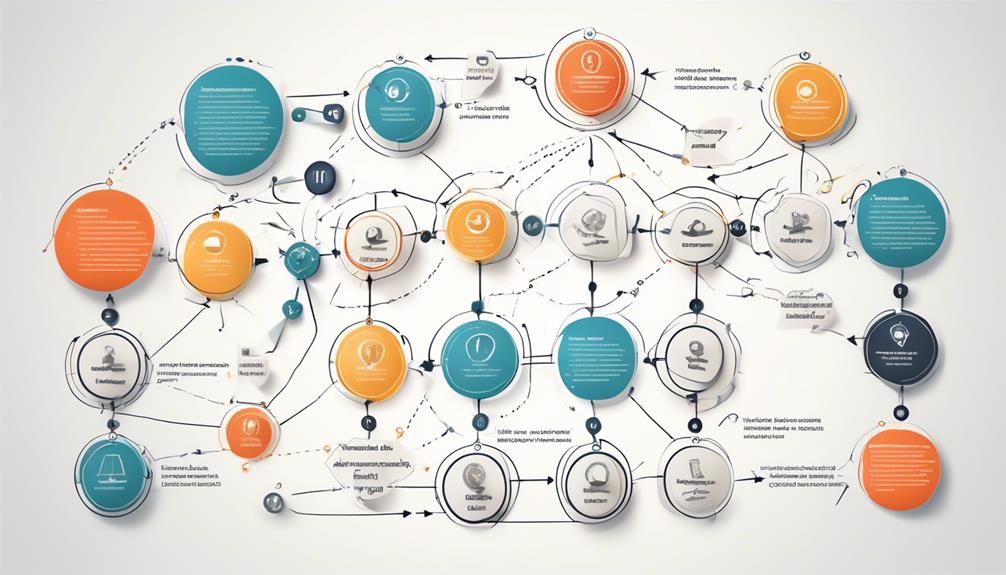To improve your QA process, adopt red team‑blue team tactics by simulating real-world cyberattacks and defending against them. Red teams probe systems, uncover vulnerabilities, and use tactics similar to malicious hackers. Blue teams focus on detection, response, and strengthening defenses. Regular exercises promote collaboration, boost skills, and help identify security gaps early. Continuing to explore these strategies will equip you with practical methods to enhance your organization’s security resilience.
Key Takeaways
- Define clear objectives and scope for red team attacks and blue team defenses to ensure targeted testing.
- Simulate realistic attack scenarios to evaluate detection, response, and recovery capabilities effectively.
- Use continuous, iterative testing to identify vulnerabilities and improve security measures over time.
- Foster collaboration and communication between red and blue teams to enhance threat understanding and defense strategies.
- Incorporate debriefs and lessons learned sessions to refine tactics and strengthen the organization’s security posture.

Have you ever wondered how organizations identify their security weaknesses before malicious hackers do? One effective method is through penetration testing, which involves simulating cyberattacks to uncover vulnerabilities within a system. Think of it as a controlled threat simulation, where ethical hackers mimic the tactics and techniques of real attackers to evaluate your defenses. This process helps you understand where your security gaps lie before someone with malicious intent exploits them. Penetration testing isn’t just about finding flaws; it’s about proactively strengthening your infrastructure by pinpointing weak spots and addressing them before they’re exploited in a real attack.
Penetration testing reveals security gaps before hackers can exploit them.
When you engage in threat simulation, you get a realistic picture of how your defenses hold up against various attack scenarios. This isn’t a simple check-the-box exercise; it’s a dynamic, hands-on process that challenges your security measures in real time. By replicating the tactics, techniques, and procedures used by adversaries, threat simulation provides insights into how well your team detects, responds, and recovers from breaches. This proactive approach ensures you’re not just reacting to incidents but actively preparing for potential threats. It also allows you to identify gaps in your security protocols, communication flows, and incident response plans, giving you a holistic picture of your organization’s resilience. Research shows that engaging with natural materials in play can enhance sensory development and emotional intelligence, which is critical for building resilient and adaptable security teams.
In a red team-blue team exercise, the red team acts as the simulated attackers, conducting penetration testing and threat simulation to find vulnerabilities. Meanwhile, the blue team defends against these simulated attacks, honing their detection and response capabilities. This adversarial setup creates a realistic environment where your security teams can practice their skills, identify weaknesses, and improve coordination. As the red team attempts to breach your defenses, the blue team learns to recognize attack patterns faster, respond more effectively, and minimize damage. The process becomes a continuous cycle of testing, learning, and refining your security posture.
Through these tactics, you’re not just relying on passive tools or periodic audits; you’re actively engaging in a thorough, ongoing security assessment. This approach helps you stay ahead of cybercriminals who are constantly evolving their methods. Penetration testing and threat simulation in red team-blue team exercises are essential for building a resilient security environment. They allow you to uncover vulnerabilities, train your staff, and develop effective response strategies. Ultimately, these tactics empower you to protect your organization’s assets more effectively and ensure your defenses are as robust as possible against ever-changing cyber threats.
Frequently Asked Questions
How Do Red and Blue Teams Coordinate During Testing?
During testing, you’ll find red and blue teams coordinate effectively through clear communication protocols and role clarity. They share information promptly, ensuring red team activities don’t interfere with blue team defenses. You’ll establish protocols for reporting vulnerabilities and responses, maintaining a structured flow. Role clarity helps each team understand their responsibilities, fostering collaboration and minimizing misunderstandings. This coordination enhances the test’s accuracy, ultimately strengthening your security posture.
What Tools Are Essential for Effective Red Team‑Blue Team Exercises?
For effective red team-blue team exercises, you need essential tools like penetration testing frameworks such as Kali Linux and Metasploit, which help simulate real threats. You should also use threat simulation platforms like Cobalt Strike to mimic attacker behavior. These tools enable your teams to identify vulnerabilities, practice response strategies, and improve overall security posture through realistic exercises. Staying equipped with these tools guarantees thorough testing and better preparedness against cyber threats.
How Is Success Measured in Red Team‑Blue Team Testing?
Imagine watching a game where every move and counter-move is tracked closely. Success in red team‑blue team testing is measured through metrics evaluation—such as detection time and breach attempts—and how well the teams communicate. Clear communication protocols guarantee everyone’s on the same page, allowing you to assess vulnerabilities effectively. When the red team’s exploits are caught and addressed swiftly, you know your defenses are stronger, and the test is successful.
What Are Common Challenges in Implementing These Tactics?
You might face challenges like resource allocation, which can limit testing scope and effectiveness, and communication barriers that hinder collaboration between red and blue teams. These issues can cause misunderstandings, delays, and reduced overall success. To overcome them, you need clear planning, open dialogue, and dedicated resources. Addressing these challenges guarantees smoother coordination, better insights, and more effective testing outcomes, ultimately strengthening your security posture.
How Often Should Red Team‑Blue Team Tests Be Conducted?
Imagine your security defenses as a fortress, constantly evolving. To keep it strong, you need regular inspections. Test frequency varies, but scheduling strategies often recommend quarterly or biannual exercises. This ensures vulnerabilities stay uncovered before attackers find them. You should adapt your testing rhythm based on your organization’s risk level, changes in infrastructure, and emerging threats. Consistent, well-planned tests help maintain resilience and readiness, like reinforcing your fortress walls before the next siege.
Conclusion
By adopting red team-blue team testing tactics, you can significantly enhance your QA process. These simulations reveal vulnerabilities and strengthen defenses, leading to more robust systems. Remarkably, studies show organizations that regularly perform such exercises reduce security breaches by up to 70%. Embracing these tactics not only identifies weaknesses early but also fosters a proactive security mindset, ensuring your systems stay resilient against evolving threats. Stay ahead by integrating red team-blue team testing into your QA strategy today.
Randy serves as our Software Quality Assurance Expert, bringing to the table a rich tapestry of industry experiences gathered over 15 years with various renowned tech companies. His deep understanding of the intricate aspects and the evolving challenges in SQA is unparalleled. At EarnQA, Randy’s contributions extend well beyond developing courses; he is a mentor to students and a leader of webinars, sharing valuable insights and hands-on experiences that greatly enhance our educational programs.










